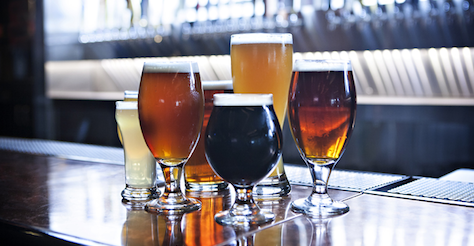The result of The Brewing Process is one of two styles of beer: Ale or Lager. Each of these begins with a different type of yeast, and the major difference during the brewing process is the temperature at which it ferments: ales use top-fermenting yeast, and ferments at higher temperatures, while lagers use bottom-fermenting yeast which goes to work more slowly and at lower temperatures. For the beer drinker, these different temperatures and brewing times create the distinctions in flavor and complexity.
Lager Styles:
Generally more crisp and lighter in color. Best consumed cold, although anything below ~38F will be too cold to taste the subtle flavors.
Ale Styles:
Usually have a more complex taste, and are best consumed cool rather than cold; 45F – 50F is a good ballpark for many of these styles.
Major Styles of Beer
From the above two types of beer there are several main beer styles that you should know about, and these will serve as great pointers to steer you towards a certain flavor profile that you are looking for. Obviously there are many sub-styles all over the world, but these are the fundamental styles of beer that they are all based upon.

Pilsner
A lager style beer, which was first created in Plzen in the Czech Republic in 1842. This is the most popular style of beer, dominating more than half of the beer market worldwide. Golden in color, the flavor is simple with light grain and hops, and a clean finish.
Popular Examples: Krombacher Pilsner, Pilsner Urquell, Lagunitas PILS, Miller Lite
Oktoberfest/Märzen
Originating in Bavaria around the 16th century, this lager style gets its name from both the month in which it is traditionally brewed (March), and the festival where the beer is first tapped (Oktoberfest). It can vary in color from pale and golden to amber and dark brown, but recent trends have preferred the golden variety. A hint of malts are present, but not too prominent.
Popular Examples: Avery The Kaiser, Hofbräu Oktoberfestbier, Stiegl Goldbräu, SurlyFest
Bock
A strong lager style from Germany, with many sub-styles such as maibock and doppelbock. A darker, copper color, while still being clear, Bock beer typically has a maltier sweetness and very light hop essence to help balance the flavor.
Popular Examples: Shiner Bock, Samuel Adams Winter Lager
Wheat
A Wheat beer is defined by having a significant amount of wheat in the mash, together with standard barley. The wheat has a lot more protein in it, which causes both the hazy, cloudy look of wheat beers, and also a thicker head; both typical characteristics of a great wheat beer.
Popular Examples: Blue Moon, Two Brothers Ebel Weiss, Three Floyds Gumballhead
Belgian
One of the widest beer varieties, Belgian ale styles includes Abbey Ale, Dubbel, Tripel, Quadrupel, Farmhouse Ale, Saision, Fruit beers, Sours, and Belgian Strong Ales. Their attributes vary wildly, but they often share an origin story revolving around local cultures and geography. To dive into Belgian ales completely, I recommend this extended guide at Serious Eats.
Popular Examples: Brasserie Dupont Saison Dupont, Lindeman Framboise Lambic, St. Bernardus Abt 12, Duvel
Pale Ale / IPA
The USA’s most popular style in recent years, Pale Ales have a larger amount of pale malts in the mash which keep their pale color intact. The amount of hops and alcohol content can increase dramatically with the India Pale Ale (and, the Double IPA), which was first done so in olde England in order to help preserve the beer on it’s long journey to colonial India.
Popular Examples: Sierra Nevada Pale Ale, Dogfish Head 90 Minute IPA, Ballast Point Sculpin IPA, Surly Furious
Stout / Porter
The word Stout comes from being used to describe the stronger variants (7-8% abv) of classic Porters. In modern times, the two terms are still very closely related, but are almost exclusively used to describe dark beers, made with roasted malt or roasted barley. The dark colors and roasted ingredients are often accompanied with flavors such as chocolate, coffee, and smoke.
Popular Examples: Left Hand Milk Stout, Deschutes Black Butte, Guinness, Revolution Eugene Porter
Cheers!
by Bottleneck Management.
The Beer 101 Series
1. What is Beer?
2. The Brewing Process
3. Types of Beer
4. Types of Beer Glasses
5. The Perfect Pour

![Styles of Beer [Beer 101 Series]](https://www.bottleneckmgmt.com/wp-content/uploads/2015/10/Styles-of-Beer-Beer-101.jpg)